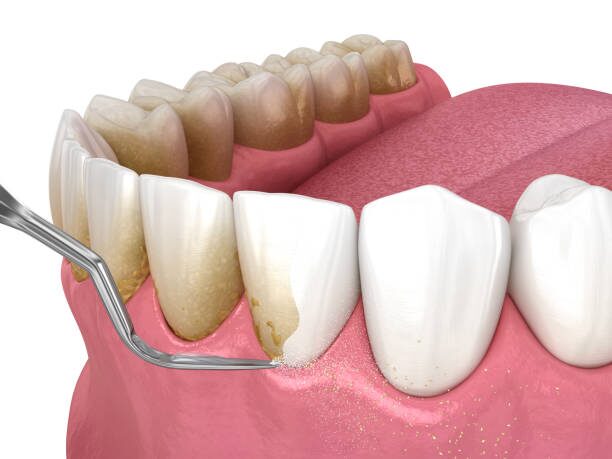
Exposed tooth roots, where the dentin layer beneath the gum line becomes visible, can significantly impact oral health and overall well-being.
This guide by Charlotte Emergency Dental delves into the intricacies of exposed tooth roots, exploring their causes, potential complications, and effective treatment options. We'll also teach you to prevent this issue and maintain a healthy, confident smile.
Our teeth are not merely the visible crowns we see when we smile. Each tooth extends below the gum line, firmly anchoring itself within the jawbone through its roots.
These roots, composed of dentin and covered by a protective layer of cementum, play a vital role in our oral health:
Healthy gingival tissues, commonly referred to as gums, function as a natural barrier. They shield the underlying tooth roots from harmful bacteria and toxins that can infiltrate the root surface and compromise its integrity.
Additionally, the gums create a tight seal around the teeth, preventing the loosening of the tooth's socket and ensuring optimal stability.
In a healthy smile, the gum tissue typically covers a significant portion of the tooth crown. If you notice your gums receding, revealing a greater portion of the tooth's root surface, it could be a sign of exposed tooth roots.
This exposed root surface usually appears yellowed or white, contrasting with the pink gum tissue.
Exposed tooth roots often present with a set of unpleasant symptoms, including:
Several factors can contribute to exposed tooth roots. Let's explore some of the most common etiologies:
Gum disease is the arch-villain behind adult tooth loss. It weakens and inflames the gums, causing them to recede and expose the tooth root. Early intervention is crucial.
Gingivitis, the opening act of gum disease, is reversible with good oral hygiene and professional dental care. But if left unchecked, gingivitis can morph into periodontitis, a more aggressive form that leads to significant bone loss and potential tooth loss.
Overly aggressive brushing techniques can damage the delicate gum tissues, leading to recession. Similarly, improper flossing that irritates the gum tissue can contribute to the problem.
Fluctuations in hormone levels during pregnancy and menopause can make gums more susceptible to inflammation and recession.
Smoking and chewing tobacco significantly increase the risk of gum disease, a major contributor to exposed tooth roots.
Teeth that are crowded or misaligned can put uneven pressure on the gums, making them more prone to recession. Orthodontic treatment can help correct misalignment and improve gum health.
A blow to the face or a dental injury can damage the gums and supporting bone, potentially exposing tooth roots.
While some degree of gum recession is a natural consequence of aging, maintaining excellent oral hygiene and scheduling regular dental checkups can help minimize its extent.
Leaving exposed tooth roots untreated can have a domino effect on your oral health, leading to a cascade of complications:
The exposed dentin in the root surface is riddled with microscopic tubules that lead directly to the tooth's nerve center. This direct pathway allows hot, cold, sweet, or sour stimuli to reach the nerve more readily, resulting in heightened sensitivity and discomfort.
Untreated exposed roots create a larger surface area for plaque and bacteria to accumulate. This buildup further irritates the gums, exacerbating gum disease. Moreover, the inflammatory response associated with gum disease can progressively break down the bone that supports the teeth.
The exposed dentin is softer and more susceptible to decay than tooth enamel. This increased vulnerability to cavities can lead to painful root infections that require prompt dental intervention.
Gum disease and inflammation compromise the supporting bone structure, causing teeth to lose their firm anchorage. This can lead to loose teeth and, in severe cases, even tooth loss.
Early diagnosis and intervention are crucial for managing exposed tooth roots effectively. Here's when scheduling a dental appointment becomes essential:
Prompt dental care can halt the progression of gum disease and prevent further complications. Early intervention can also help preserve the health of your tooth roots and surrounding bone structure.
Don't ignore any signs that might indicate exposed tooth roots. Schedule a dental appointment if you experience:
The course of treatment for exposed tooth roots depends on the severity of the condition and the underlying cause. Here's an overview of potential treatment options:
For mild cases of gum disease and exposed roots, a dentist may recommend scaling and root planing, a deep cleaning procedure.
This professional cleaning removes plaque and tartar buildup from below the gum line, creating a clean and healthy environment for the gums to reattach to the tooth surface.
For severe gum recession, surgery might be needed in the form of gum grafting. This procedure involves taking a healthy piece of gum tissue from another location in your mouth and using it to rebuild the gum line around the exposed root.
For exposed roots with existing decay or significant sensitivity, restorative procedures like fillings or crowns may be recommended. Fillings replace damaged tooth structure, while crowns provide a complete cap for the tooth, protecting the exposed root surface and restoring functionality.
Treating the underlying cause of exposed tooth roots is vital for long-term success. This may involve addressing gum disease with medication or further dental procedures, modifying brushing habits to be gentler on the gums, or quitting smoking to improve overall oral health.
Charlotte Emergency Dental offers comprehensive dental services, including treatment for exposed tooth roots. We prioritize convenient scheduling and, in many cases, same-day treatments and offer financing options to make dental care accessible.
Contact us today to schedule a consultation and restore your oral health and confidence.

Exposed tooth roots are a treatable dental concern. Early diagnosis and proper intervention are key to restoring optimal oral health. By understanding the causes, symptoms, and treatment options, you can take control of your oral health and maintain a beautiful smile for years to come.
Remember, practicing excellent oral hygiene habits, scheduling regular dental checkups, and addressing any risk factors can significantly reduce your chances of developing exposed tooth roots.

We have temporarily updated our hours, reflected below.
MONDAY to FRIDAY
9:00am – 7:00pm
SATURDAY to SUNDAY
9:00am – 3:00pm
Save time, print online! Fill out forms online before your first visit to shorten your appointment time with us.